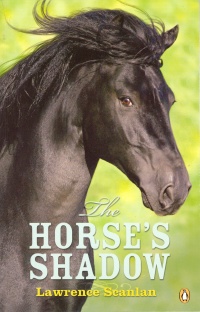| ________________
CM . . .
. Volume XII Number 1 . . . .September 2, 2005
excerpt:
When 14-year-old Claire Vigere, who is "the horse's shadow," runs away from home, her siblings pose the questions in the excerpt. In a sense, Claire does go to Hell, since war is hell, and the American Civil War particularly gruesome. When the novel begins, Claire is living with her extended family in L'Ange Gardien, a real village in Canada East, close to the American border. It is 1863. Just four years later, with Confederation, Canada East will become Quebec. Claire's favourite person is her grandfather, Ambrose. Although she has been introduced to women's traditional farm chores, her preferred activity is to care for the horses, especially Beau Albert and Tibeau. These animals are descendants of horses specially bred for King Louis XIV and first brought to New France in 1610. Claire learns all aspects of their care and training from her grandfather, and she loves to participate in races. Times are hard on Québécois farms in the Eastern Townships. There has been too much subdivision of land with each generation: "Too much was asked of the soil and the soil grew weary." Claire has seen bailiffs evict rural families, seizing their worldly goods to pay their debts. Her father has borrowed money to run the farm and manages to repay the interest, but never the principal. The chance to get out of debt comes when a Yankee horse dealer sees Beau Albert and Tibeau at the ice races on Lake Champlain and offers the enormous sum of $1,000 for them. Horses are badly needed for the war going on south of the border. Kingston author Lawrence Scanlan, who has written other books about horses, is a fund of obscure horse lore. Did you know, for instance, that a cavalry officer's horse had to be replaced every two months during the Civil War? In two months, an animal was either killed in battle or died of exhaustion. Scanlan is dextrous in showing Claire is a francophone, while supplying a translation for anglophone readers. When Claire talks to Beau Albert, for example, we read: "Vite, vite," she said softly. "Quick, quick." Intriguingly, Scanlan introduces several real people from the era, including the painter Cornelius Krieghoff. Claire's grandfather buys her a book of reproductions of the artist's work; it is on the backs of pages ripped from this volume that she writes home. At the end of the novel, Krieghoff appears in a scene and asks Claire to let him feature her in three paintings: one capturing her as a village girl, another showing her as a boy-soldier, and the third of her as a young woman. In his Author's Note, Scanlan directs readers to Dennis Reid's Krieghoff: Images of Canada, to see the paintings described in the novel. These clever elements of plot and setting are somewhat overshadowed by certain problematic narrative techniques which make the novel a Clydesdale, not a Triple Crown winner. Caught up in the fictional dream, readers enjoy learning new things if they're presented subtly. Scanlan's research is a bit too obvious, resulting in more of a history text than a novel. He missed a great opportunity for drama when Claire and the 1st Massachusetts Cavalry first see a battlefield. This section is actually summarized in point form! On one key occasion, Scanlan ignores history. Surely it strains credulity to have Claire's young comrade, Moses, ask her to marry him, even as a joke. Moses is black; Claire is white; the place is the United States in 1864. Early in the novel, the story needs some spurring on. The introduction of the American horse dealer, on page 18, is Claire's first inkling, and the reader's, that Tibeau and Beau Albert may be sold. On page 66, Claire's father breaks the news that he is selling the horses. Immediately, she begins a course of action, and the story starts moving along. While reading the 48 pages in between, which are informative but not suspenseful, I longed to shout, "Giddy-up!" Will young channel surfers wait for the novel to start moving, or will they put it out to pasture? We "know of" Claire because we are told about her. The old adage, "Show, don't tell," is employed unevenly in this novel. Too often, she seems at a distance. Fiction is supposed to transcend time and make the shadows of bygone days come alive. First person narrative might have made The Horse's Shadow more vivid and compelling. Recommended with reservations. Ruth Latta's latest novel, The Secret of White Birch Road, set in Northern Ontario in 1952-3, centres on three teenaged girls. It is in the process of being published by Baico Publishing of Gatineau, Quebec. Ruth lives in Ottawa, ON.
To comment
on this title or this review, send mail to cm@umanitoba.ca.
Copyright © the Manitoba Library Association. Reproduction for personal
use is permitted only if this copyright notice is maintained. Any
other reproduction is prohibited without permission.
NEXT REVIEW |
TABLE OF CONTENTS FOR THIS ISSUE
- September 2, 2005.
AUTHORS |
TITLES |
MEDIA REVIEWS |
PROFILES |
BACK ISSUES |
SEARCH |
CMARCHIVE |
HOME |
